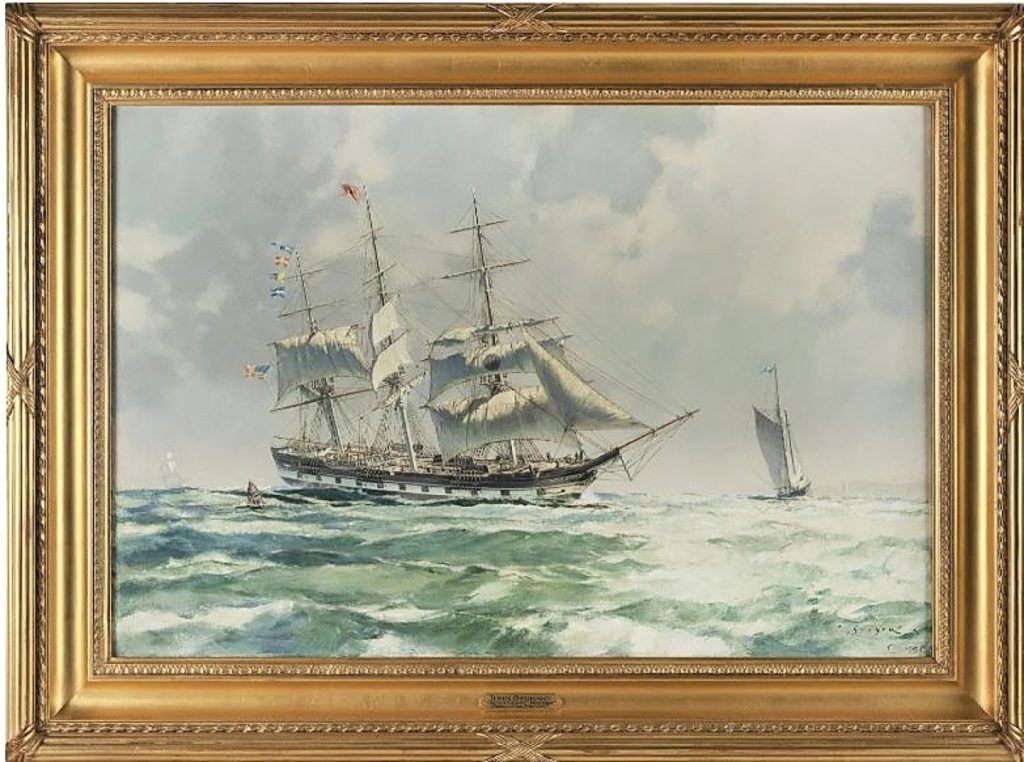
English maritime artist John Stobart passed away at the age of 93 on March 2, the day after his painting titled “Packet Great Western Approaching New York,” sold for $59,375, the top lot in Eldred’s Marine Sale Session II. Signed lower right “Stobart 68,” titled on a gallery label verso and on a frame plaque, the oil on canvas measured 33 by 44 inches, framed. The ship, designed and built by William Webb in 1851, was the largest vessel to date of the Black Ball Line, designed for domestic mail, passenger and freight transportation.
Review by W.A. Demers, Photos Courtesy Eldred’s
EAST DENNIS, MASS. – The top lot in Eldred’s Marine Sale Session II on March 1 was a painting by John Stobart (English, 1929-2023) titled “Packet Great Western Approaching New York,” selling for $59,375. Signed lower right “Stobart 68,” titled on a gallery label verso and on a frame plaque, the oil on canvas measured 33 by 44 inches, framed. Designed and built by William Webb in 1851, the packet ship Great Western was the largest vessel to date of the Black Ball Line. Packet ships were designed for domestic mail, passenger and freight transportation in European countries and in North American rivers. The Great Western was a fast and sturdy vessel and completed many transatlantic crossings before she was sold in 1878.
On March 2, the day after Eldred’s auction, Stobart, one of the world’s most renowned maritime artists, passed away at 93 years old. A remembrance published by Rehs Galleries, New York City, cited Stobart as “widely celebrated for his breathtaking depictions of historic maritime scenes both at sea and important port cities.” His works can be found in the collections of museums, corporations and private collectors around the world.
Born in Leicester, England, Stobart, surrounded by the beautiful countryside, developed an early appreciation for landscape, but at the age of 8, a visit to his grandmother’s home in the north allowed him an excursion to the port of Liverpool – at the time, the busiest port in England. This sparked his lifelong desire to capture the excitement of world trade that comes to life in a port. Stobart would go on to study at the Derby College of Art and the Royal Academy in London, where he developed his skills in composition and perspective.
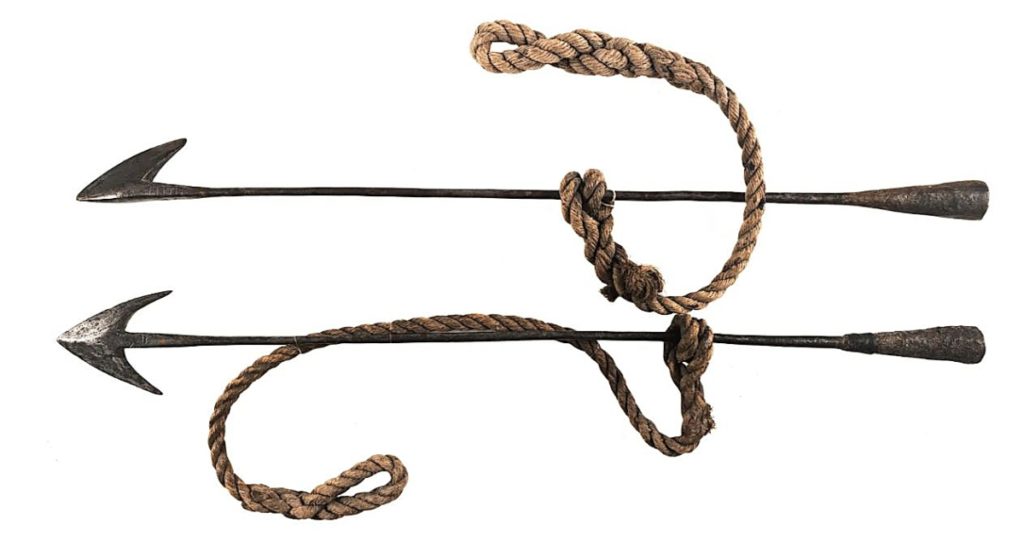
Two Lake & Burgess harpoons, both purportedly used on the same whaling voyage on the Fenelon, took $5,000.
Eldred’s two-session sale – the first was conducted on February 28 and the second on March 1 – was sea-to-shining-sea full of maritime-related lots, everything from stately ships portraits to Nineteenth Century blubber forks, with choice scrimshaw, sailors’ logs and navigational tools adding to the diverse offerings. Ships portraits seemed to carry the day. “The paintings have really rebounded since 2008, although they’re not completely rebounded from what they were in the early 2000s,” said Bill Bourne, Eldred’s vice president.
The two-day total was $843,750 and the sell-through rate was 77 percent. A total of 243 registered bidders lined up on the phones, in the gallery or with left bids and online to compete for the 635 lots on offer. “I think it did well overall. There was a little weakening in the scrimshaw market, but that could be due to the fact that we’ve put up how many pieces over the past six or seven years and collectors’ shelves are getting full,” said Bourne. “We had three or four of the best collections come on the market in the last 30 years, and when that happens it tends to fill up the shelves of the major collectors. So they’re very selective as to what they’re buying.”
In addition to the top-selling Stobart, which went to an East Coast private buyer bidding in the room, there were several paintings in the sale by Nineteenth Century ships portraitist Antonio Nicolo Gasparo Jacobsen (1850-1921), a Danish-born American maritime artist known as the “Audubon of Steam Vessels.” The most notable lot in the sale was his “The Steam/Sail Ship Belgravia,” which realized $18,750, signed, dated and inscribed lower right “A. Jacobsen 1889 705 Palisades Av., West Hoboken, NJ,” the 22-by-36-inch oil on canvas depicted the transatlantic liner that served in the 1880s and early 1890s, mostly transporting immigrants, underway. She was wrecked in 1896.
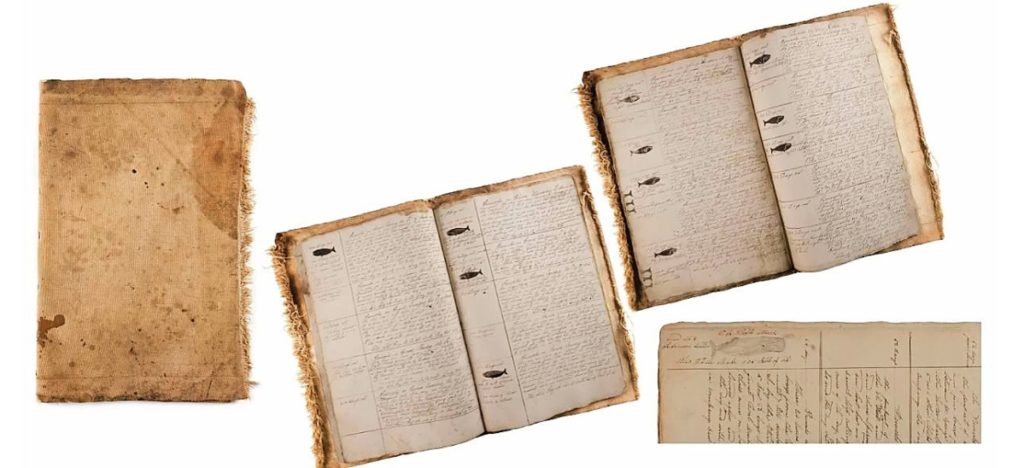
A double whaling journal from the whaleship ,Hudson, reached $10,000 and included approximately 28 whale stamps and drawings of whales.
The American clipper ship Herald of The Morning from the Kelton collection of marine art and artifacts sailed quickly across the block to finish at $9,375. Painted by William Gay Yorke (1870-1892), the 29½-by-42¼-inch oil on canvas showed the medium clipper designed by Samuel H. Pook under sail. From 1855 to 1875 she made 18 west-bound passages around Cape Horn to the West Coast and Pacific island ports, according to catalog notes. They added that during that time her record as a fast sailing ship was well established. The US bark seen in the background of the painting has flags showing the First Distinguishing Pennant and number 289, identification for the Amazon.
Yachting interest was addressed by Danish painter and graphic artist Thomas Petersen’s (1861-1926) portrait of white-hulled yacht cutting through the water. The oil on canvas, 18 by 28 inches, was signed and dated lower left “Thos Petersen 1914” and realized $4,375.
The Kelton collection of marine art and artifacts also contributed the Gold Rush-era journal of the brig Amelia on a voyage from Maine to San Francisco, November 1849-May 1850. Going out at $12,500, the 20,000-word journal featuring a watercolor frontispiece and seven well-drawn tipped-in watercolor illustrations had been kept by Capt. Joseph Clark, with additional daily entries by D.C. Powers of Eastport, Maine, describing his voyage aboard the hermaphrodite brig Amelia from Eastport to the California gold fields. The journal’s watercolor illustrations depicted highlights from the voyage, including a highly detailed hand-drawn and colored map of Amelia’s track around Cape Horn.
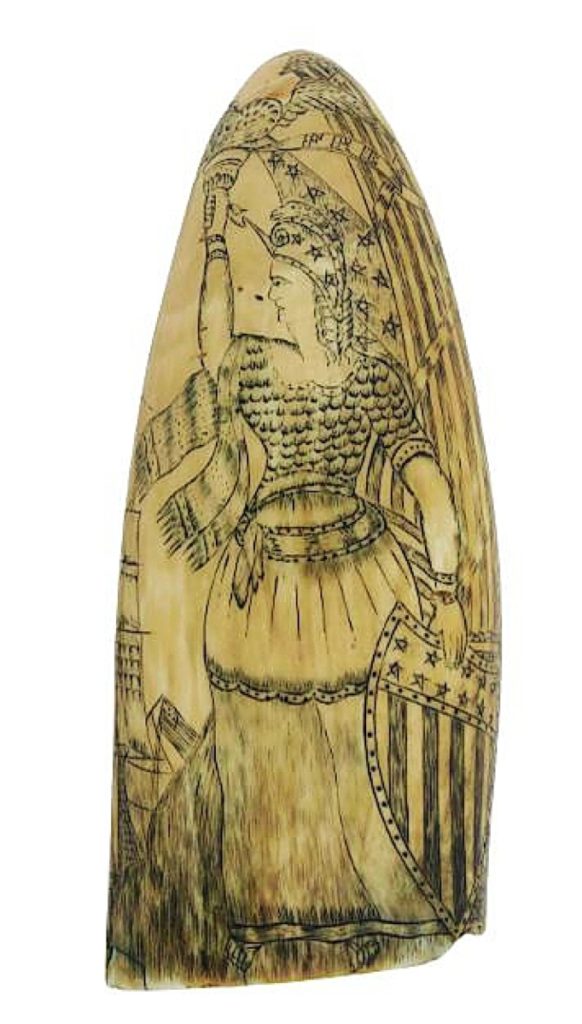
Fetching $8,125 was a scrimshaw whale’s tooth depicting Lady Liberty and attributed to Samuel W. Tenney, a mid-Nineteenth Century artist also known as the “King of the Sea.” A barefoot and helmeted Liberty holds aloft a chalice and grasps a Stars and Stripes shield at her side as she gazes out to sea. The 5¼-inch tooth exhibited great patina and had provenance to Nina Hellman Antiques of Nantucket, Mass.
That harrowing trip around the horn no doubt could have benefited from a choice navigational tool offered in the sale. It was an Eighteenth Century Arabic quadrant from the Maghreb region of northwest Africa. The circa 1776 quadrant, which found a buyer at $11,250, was signed in Arabic along one of the sight vanes “Made by the little slave of his Lord, Ahmad b’Ali Marsil, year one thousand one hundred and ninety” (1190 A.H., equivalent to 1776-77 CE). Catalog notes described the instrument, stating, “one side of the brass plate with an engraved astrolabe quadrant with data for 35 degrees north latitude. This line of latitude runs through the Maghreb region in northwest Africa, which comprises current-day Morocco, Algeria and Tunisia. One of the radial edges has been cut with a long indentation to provide two ‘sight’ vanes, and a plumb bob is attached by a string to the apex.” The quadrant’s sight used gravity to align the plumb bob with the index reading when a celestial body was observed by eye over the top of the instrument along the sighting vanes. The string was then clamped by the observer’s finger against the index, and the angle read. It had a height of 7½ inches and width of arc of 10¼ inches.
Another journal, this one a double whaling journal from the whaleship Hudson, reached $10,000. The Hudson, of Sag Harbor, N.Y., commenced its first voyage on May 27, 1835, and ended it on July 2, 1836. Its final entry stated, “Ship Voyage 13 Months 6 Days 1,400 Barrels Whale 520 of Sperm and 14,000 Pounds of Bone.” Included were approximately 28 whale stamps and drawings of whales.
And what would a marine auction be without items attributed to creative Nineteenth Century sailors with lots of time on their hands? Fetching $8,125 was a scrimshaw whale’s tooth depicting Lady Liberty and attributed to Samuel W. Tenney, a mid-Nineteenth Century artist also known as the “King of the Sea.” On the tooth, a coastal scene wraps around its circumference, depicting a barefoot and helmeted Liberty holding aloft a chalice and grasping a Stars and Stripes shield at her side as she gazes out to sea. Next to her are a fouled anchor, a pile of cannonballs and an urn-topped monument draped in American flags. At the tooth’s tip, an eagle entwined with a “Liberty and Freedom” banner drinks from the chalice. The 5¼-inch tooth exhibited great patina and had provenance to Nina Hellman Antiques of Nantucket, Mass. “Exceptional work, no doubt about it,” observed Bourne. “He was pretty prolific in his work. We had a tusk by him that was in the Vardeman collection about four years ago.”
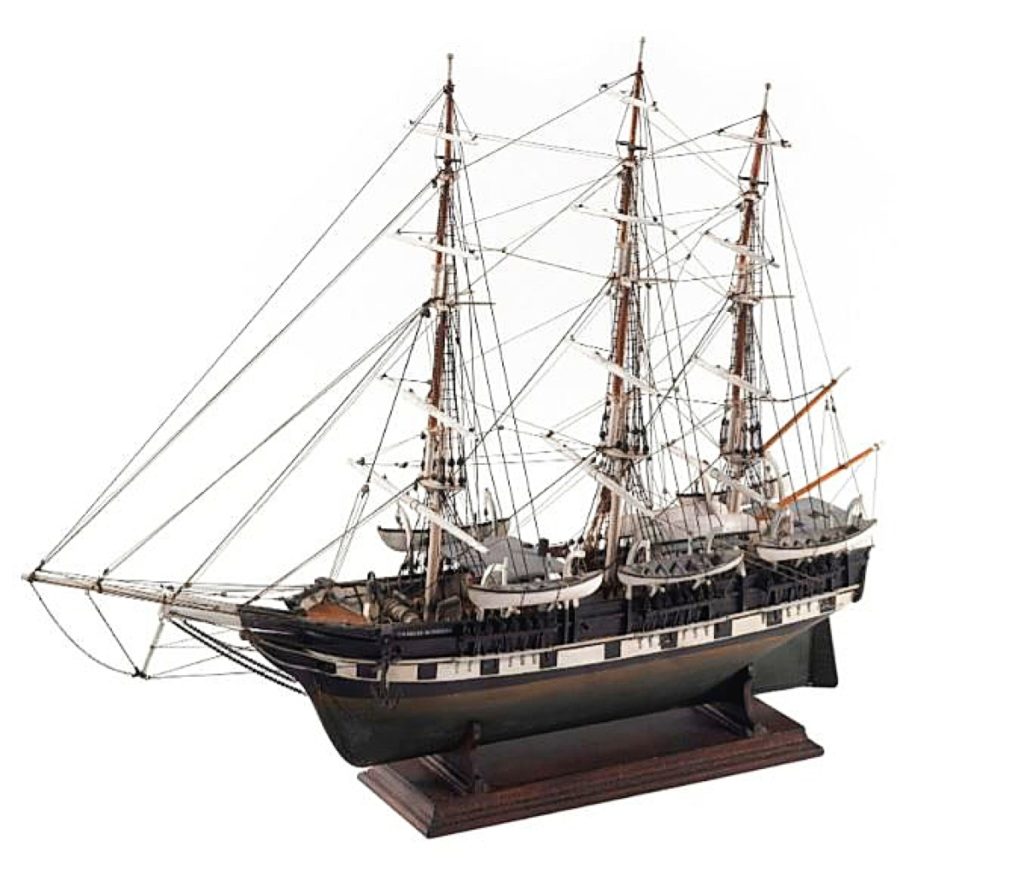
A model of the whaleship ,Charles W. Morgan, first half of the Twentieth Century, brought $6,250.
Also notable was a late Twentieth Century sailor’s valentine composed of multicolored shells in geometric and floriform patterns and housed in an oblong mahogany case. At 18 inches long by 11 inches wide, it left the gallery at $8,125.
A knockout punch was delivered by an extraordinary clenched-fist cane at $7,500, which went to a private New England collector having what Bourne characterized as a “really good collection.” Its whale ivory handle was carved as a right fist tightly clenching a snake that coiled about the hand and wrist, tilting its head and menacing with inlaid eyes and a flicked, forked tongue. It was 37¼ inches long with a tall whale ivory throat formed as two octagonal columns, one with gothic arch panels and one fluted, with baleen and ring spacers. “It was a spectacular cane, reshafted with the gothic panels below the clenched fist,” said Bourne. “If it had had the typical whalebone twist shaft, it would have probably brought $30,000 to $50,000.”
Additional highlights included a Nineteenth Century dirk that had been presented to Captain William Driver from Salem, Mass., who is credited with nicknaming the American flag “Old Glory,” $6,250; a model of the whaleship Charles W. Morgan, first half of the Twentieth Century, also $6,250; two Lake & Burgess harpoons purportedly both used on the same whaling voyage on the Fenelon, $5,000; a scarce late Nineteenth/early Twentieth Century US Life Saving Service badge from the collection of Chuck and Jan Deluca, $4,687; and that rare blubber fork, mid-Nineteenth Century – “The first blubber fork we have handled in at least several decades” – wrote Bourne in the notes. From the collection of Chuck and Jan Deluca and measuring 69 inches long, it snagged $2,125.
Prices given include the buyer’s premium as stated by the auction house. The firm’s next major marine auction will take place in early August, date to be announced. In early May, there will be a “marine-lite” sale combined with antiques. For information, www.eldreds.com or 508-385-3116.




